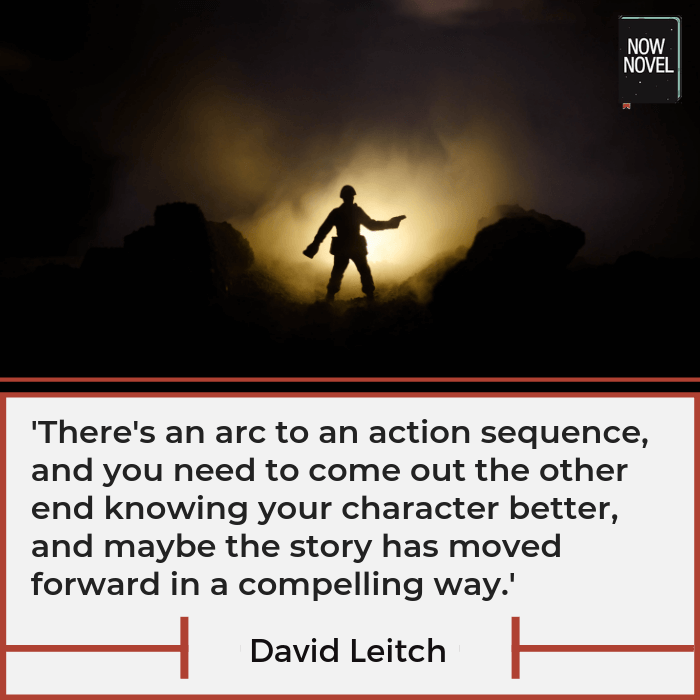Whether you’re writing a breakneck thriller, action screenplay or a script for a video game or graphic novel, writing action scenes that keep readers (or viewers) entertained is essential. Read 6 ways to make scenes more gripping:
1. Keep exposition focused and relevant to coming action
Exposition – the narrative introducing a story or scene – easily becomes directionless.
In an action scene, your reader doesn’t need to see the moment your character wakes up, what cereal they have for breakfast. The rising action – events contributing to the main story’s tensions – matters.
Great action scenes keep exposition taut and focused on pressing matters. The exposition typically supplies minimal details such as:
- Place: Where are we now? For faster pace, try to paint your scene’s opening setting in few sentences or less.
- Stakes: What is the situation for characters going into the scene and what’s at risk?
- Tone and mood: Is the tone tense? Paranoid? Mysterious? Look for examples from books you love that you remember as having compelling tone and take notes on how your favourite authors achieve these effects
Example of effective action scene exposition: David Mitchell’s Cloud Atlas
In a tense scene from David Mitchell’s Cloud Atlas (2004), intrepid reporter Luisa Rey investigates a cover-up of environmental misdeeds at a power plant.
Right after a scene transition, we see Luisa approach the power station:
Luisa’s rust-orange VW Beetle travels a flat road towards a kilometer-long bridge connecting Yerbas Cape to Swannekke Island, whose power station dominates the lonely estuary. The bridge checkpoint is not quiet today. A hundred-strong demonstration lines the last stretch, chanting, ‘Swannekke C Over Our Dead Bodies!’ A wall of police keeps them back from the queue of nine or ten vehicles. Luisa reads the placards while she waits. YOU ARE NOW ENTERING CANCER ISLAND, warns one, another, HELL, NO! WE WON’T GO! and, enigmatically, WHERE OH WHERE IS MARGO ROKER?
David Mitchell, Cloud Atlas (2004), p. 101.
Mitchell’s exposition creates tension on multiple levels. Not only is Luisa venturing closer to the object of her report (and the dangerous people in command). The protest also conveys the power of her opponent: Even a crowd of people a hundred strong is powerless to stop the utility’s operators and their henchmen. They simply have greater firepower (the police) on their side.
The demonstrators’ signs convey a sense of danger (‘CANCER ISLAND’) and even imply that the powerful people at the helm of the utility are capable of making people disappear (the mysterious reference to a missing ‘Margo Roker’).
These details focus on the main background – Luisa’s investigation of the plant and its misdeeds. None of the exposition is irrelevant to Luisa’s goal – furthering her investigation. Instead, it creates a growing sense of Luisa’s dangerous position, promising action.
2. Keep dialogue action-focused
Riveting action scenes stay clear of meandering dialogue. To make even characters’ conversations action-packed:
- Use shorter sentences: Brief, brusque words help create urgency
- Use interruption: When characters are in a hurry they may cut each other off
- Front-load verbs: Instructions, orders and commands are action-focused phrases (e.g. ‘Go now!’ or ‘Get over here … quickly!’)
Example of urgent action scene dialogue: Cloud Atlas
Further on in the chapter detailing Luisa Rey’s investigation, her associate Rupert Sixsmith (who’s passed her sensitive information to aid her investigation) receives a troubling phone call:
The telephone rings. Sixsmith snatches it up. ‘Megan?’
Mitchell, Cloud Atlas, p. 108.
A brusque male voice. ‘They’re coming.’
‘Who is this?’
‘They traced your last call to the Talbot Motel, 1046 Olympus Boulevard. Get to the airport now, get on the next flight for England, and conduct your exposé from over there, if you must. But go.’
‘Why should I believe-‘
‘Use logic. If I’m lying, you’re still back in England safe and sound – with your report. If I’m not lying, you’re dead.’
Most of the sentences here follow the first rule above. Some have three words, some only two. This clipped quality creates an urgent sense of momentum.
The ‘brusque male voice’s’ use of the imperative mood (‘go’, ‘use logic’) shifts our attention to urgent actions Sixsmith may take as soon as the call ends.
Even though the phone call itself is not full of action, it suggests intense impending action. Each element of the scene, including dialogue, helps to make the reader ask ‘What will happen next?’
3. Write suspenseful, active narration
In a good action scene, even narration creates a sense of movement and the tension from one uncertain moment to another.
Active narration example: Dashiell Hammett’s ‘The Glass that Laughed’
Consider this character description from the short story ‘The Glass that Laughed’ by the hard-boiled detective fiction author Dashiell Hammett. The protagonist, Norman Bacher, has killed his brother and is haunted by seeing his brother’s face in his own reflection:
Coming home from the bank that same afternoon he took his first definite step in flight from his dead brother’s face. The mirrored chewing-gum machine in First street was in his path. Approaching, he kept his eye steadily upon it until he came abreast. Then he spied Mrs. Dunan, the bank president’s wife, coming toward him. He hastily looked away from the mirror. He feared that if he saw Eric in the glass this second time he might be startled into some momentary gesture of betrayal. So he turned his eyes toward Mrs. Dunan, and lifted his hat — but in the very act of averting his eyes from the mirror he had caught a flash of Eric’s face.
Dashiell Hammett, ‘The Glass that Laughed’ Read in full at Electric Literature.
Simple objects – the mirrored chewing-gum machine, for example – acquire a degree of menace that makes Hammett’s narration suspenseful. Because of Norman’s tortured psychological state, everything reflective becomes a potential cause for him to give himself and his guilt away.
Thus even small actions and gestures – looking, or not looking, in shop windows – acquire a heightened degree of tension.
Also note the intensity of Hammett’s verbs. Norman ‘spies’ Mrs Duncan’s approach. He catches a ‘flash’ of Eric’s face in his own reflection. Gestures and movements are furtive and quick, creating a fearful, tense mood.
[Get feedback on your narration and other aspects of your action scenes in our peer critique forum.]

4. Involve your reader’s senses
Our senses are an important part of how we get engrossed in a book or screenplay. Think for example of a high-speed car chase in an action movie scene. List sound effects you might hear. They might include:
- sirens
- screeching tyres
- gunfire
- exagerrated heartbeat effects
- the sound of breaking glass
- slamming car doors
- running feet
Great action scenes create a vivid sense of what it would be like to be present. Part of this requires involving our imaginations via the senses of sound, smell, and touch.
Take for example, this passage from William Golding’s Lord of the Flies (1954) in which teenage boys stranded on an island in search of food come across a piglet:
Effective sense description in action: Lord of the Flies
They were in the beginnings of the thick forest, plonking with weary feet on a track, when they heard the noises—squeakings—and the hard strike of hoofs on a path. As they pushed forward the squeaking increased till it became a frenzy. They found a piglet caught in a curtain of creepers, throwing itself at the elastic traces in all the madness of extreme terror. Its voice was thin, needle-sharp and insistent.
William Golding, Lord of the Flies (1954), p. 23.
Golding writes the scene so that the volume builds to a crescendo. At first it is ‘noises – squeakings’. Then we hear the ‘hard strike’ of the piglet’s hoofs and the squeaks become ‘a frenzy’. As the boys come across the sight of the piglet, too, the sense description grows more detailed. We can almost hear the piglet’s ‘thin, needle-sharp and insistent’ voice.
Golding uses sound description in this passage to create a vivid sense of the action – the piglet’s entrapment creates a fearful tone that mirrors the boys’ own uneasy situation – stranded as they are on the island.
5. Develop action characters’ goals and motivations
Even in a scene where the focus is on action, interesting charactersization is important. A ‘mindless action flick’, the type where the hero is little more than a buff cardboard cutout, may be entertaining. Yet visual storytelling has the advantage of special effects, stunts – the entertainment value of visual spectacle – to keep viewers hooked.
In a written action story, there is no Dolby surround sound. Giving your characters interesting goals and motivations, and developing characters from scene to scene while they pursue said goals, adds other areas of interest to your story (beyond ceaseless close scrapes and death-defying hijinks).
Even the spy action icon James Bond has some character development. In Ian Fleming’s On Her Majesty’s Secret Service, for example, Bond’s new wife Tracy is killed.
Surprise developments in action characters’ arcs like these keep their lives more unpredictable and interesting than if they were to always save the day with zero development, personal stakes and losses.

6. Give your action scenes arcs
The example from Golding’s Lord of the Flies above illustrates important elements of action scenes: rising and falling action.
In a nail-biting action scene, intensity rises and falls from moment to moment. After the boys come across the piglet, there’s an uncomfortable, unsettling moment where it seems they are about to kill it. The action rises to a high of tension:
The three boys rushed forward and Jack drew his knife again with a flourish. He raised his arm in the air. There came a pause, a hiatus, the pig continued to scream and the creepers to jerk, and the blade continued to flash at the end of a bony arm. The pause was only long enough for them to understand what an enormity the downward stroke would be. Then the piglet tore loose from the creepers and scurried into the undergrowth. They were left looking at each other and the place of terror. Jack’s face was white under the freckles. He noticed that he still held the knife aloft and brought his arm down replacing the blade in the sheath. Then they all three laughed ashamedly and began to climb back to the track.
Golding, Lord of the Flies, p. 23.
Jack’s knife held aloft is also the high point of the scene’s drama. It’s then that we have the sudden escape of the pig, and the bathos (anticlimax) of the boys’ ashamed laughter, lowering the tension again.
Think of how your scenes and build to high-action, high-intensity events, and how they can also subvert what the reader might be expecting at any given moment.
Get pro feedback and help giving your story the action and development it needs when you work with a writing coach. See what other coached authors say.


2 replies on “Writing action scenes: 6 ways to keep scenes riveting”
Number one is the most important lesson for the new (or not-so new) writer to master.
Thanks for sharing your thoughts and for reading, Elias! Have a great week.